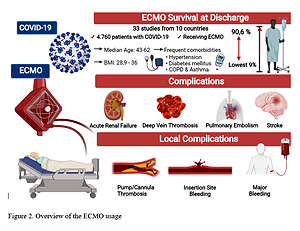Current issue
Archive
Manuscripts accepted
About the Journal
Editorial office
Editorial board
Section Editors
Abstracting and indexing
Subscription
Contact
Ethical standards and procedures
Most read articles
Instructions for authors
Article Processing Charge (APC)
Regulations of paying article processing charge (APC)
COVID-19/SARS-COV-2 / SYSTEMATIC REVIEW/META-ANALYSIS
The use of extracorporeal membrane oxygenation in COVID-19: a systematic review
1
Cardiology Department, Cardiovascular Diseases Institute “Prof. Dr. George I.M. Georgescu”, University of Medicine and Pharmacy „Grigore T.Popa”, Iași, Romania
2
Cardiology and Internal Medicine Department, University of Medicine and Pharmacy “Grigore T. Popa”, Iasi, Romania
3
Department of Internal Medicine II – Division of Nephrology, “Victor Babeș” University of Medicine and Pharmacy, Timisoara, Romania
4
Centre for Molecular Research in Nephrology and Vascular Disease, Faculty of Medicine, “Victor Babeș” University of Medicine and Pharmacy, Timisoara, Romania
5
University of Medicine and Pharmacy “Grigore T. Popa”, Iasi, Romania
6
Citadin SA, Iasi, Romania
7
Physical Medicine and Rehabilitation Department, Rehabilitation Clinical Hospital, Iasi, Romania
8
Department of Medicine, Koc University School of Medicine, Istanbul, Turkey
9
Nephrology Department, “C. I. Parhon” Hospital, University of Medicine and Pharmacy, “Grigore T. Popa”, Iasi, Romania
10
Research Methodology and Evidence Based Medicine Center, University of Medicine and Pharmacy „Grigore T.Popa”, Iasi, Romania
Submission date: 2022-03-04
Final revision date: 2022-06-28
Acceptance date: 2022-07-11
Online publication date: 2023-01-20
Corresponding author
Georgiana Ionescu
Cardiovascular Diseases Institute "Prof. Dr. George I.M. Georgescu", Iasi, Iasi, Romania
Cardiovascular Diseases Institute "Prof. Dr. George I.M. Georgescu", Iasi, Iasi, Romania
KEYWORDS
COVID-19SARS-CoV-2acute respiratory distress syndromeextracorporeal membrane circulatory oxygenationsurvivalmechanical circulatory supportextracorporeal life support
TOPICS
ABSTRACT
Introduction:
The COVID-19 pandemic represents a major worldwide challenge, with a great impact on health systems and economic mechanisms. SARS-CoV-2, the pathogenic agent that generates COVID-19, creates a wide variety of organ dysfunctions, from acute respiratory distress syndrome (ARDS) to acute myocardial infarction or pulmonary embolism. Mechanical circulatory support devices such as extracorporeal membrane circulatory oxygenation (ECMO) have shown their efficacy in maintaining organ perfusion in respiratory and cardiac impairments. With this review, we aimed to assess the impact of ECMO use in COVID-19 patients with ARDS.
Material and methods:
We performed a systematic review to find studies using ECMO in COVID-19. Comorbidities, side effects, and survival rate to discharge were analysed. The literature search was done using PubMed/MEDLINE, Web of Science, Embase (Elsevier), the Cochrane Central Register of Controlled Trials (Wiley) and clinicaltrials.gov databases (inception (December 2019) to October 16, 2021), by 2 authors.
Results:
We included 33 studies from 10 countries with a total of 4760 patients receiving ECMO for COVID-19. The survival rate varied from 9% to 90.6% at discharge. The most serious adverse events were acute kidney injury (up to 87%), major bleeding (up to 92.1%), strokes or cerebral haemorrhage (up to 34%). Other complications such as pulmonary embolism, peripheral bleeding, or sepsis had a major impact on survival rates.
Conclusions:
ECMO in COVID-19 patients may be a useful rescue therapy instrument, but due to the great variability of studies and still unknown mechanisms and effects of SARS-CoV-2, further studies need to be done.
The COVID-19 pandemic represents a major worldwide challenge, with a great impact on health systems and economic mechanisms. SARS-CoV-2, the pathogenic agent that generates COVID-19, creates a wide variety of organ dysfunctions, from acute respiratory distress syndrome (ARDS) to acute myocardial infarction or pulmonary embolism. Mechanical circulatory support devices such as extracorporeal membrane circulatory oxygenation (ECMO) have shown their efficacy in maintaining organ perfusion in respiratory and cardiac impairments. With this review, we aimed to assess the impact of ECMO use in COVID-19 patients with ARDS.
Material and methods:
We performed a systematic review to find studies using ECMO in COVID-19. Comorbidities, side effects, and survival rate to discharge were analysed. The literature search was done using PubMed/MEDLINE, Web of Science, Embase (Elsevier), the Cochrane Central Register of Controlled Trials (Wiley) and clinicaltrials.gov databases (inception (December 2019) to October 16, 2021), by 2 authors.
Results:
We included 33 studies from 10 countries with a total of 4760 patients receiving ECMO for COVID-19. The survival rate varied from 9% to 90.6% at discharge. The most serious adverse events were acute kidney injury (up to 87%), major bleeding (up to 92.1%), strokes or cerebral haemorrhage (up to 34%). Other complications such as pulmonary embolism, peripheral bleeding, or sepsis had a major impact on survival rates.
Conclusions:
ECMO in COVID-19 patients may be a useful rescue therapy instrument, but due to the great variability of studies and still unknown mechanisms and effects of SARS-CoV-2, further studies need to be done.
Share
RELATED ARTICLE
We process personal data collected when visiting the website. The function of obtaining information about users and their behavior is carried out by voluntarily entered information in forms and saving cookies in end devices. Data, including cookies, are used to provide services, improve the user experience and to analyze the traffic in accordance with the Privacy policy. Data are also collected and processed by Google Analytics tool (more).
You can change cookies settings in your browser. Restricted use of cookies in the browser configuration may affect some functionalities of the website.
You can change cookies settings in your browser. Restricted use of cookies in the browser configuration may affect some functionalities of the website.



